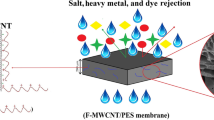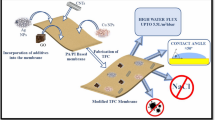Abstract
Membrane fouling limits membrane performance and membrane applications. Changing the membrane surface properties may effectively alleviate membrane fouling. Preparing conductive membranes is an efficient way to achieve this goal. In this paper, the polypyrrole–carbon nanotube/polyethersulfone composite membranes (PPy–CNT/PES) were successfully fabricated via a process of chemical polymerization of pyrrole on the CNT/PES substrate. The resistivity, pure water flux, as well as the fouling prevention performance of the PPy–CNT/PES membrane were systematically studied. The electric resistance of the PPy–CNT/PES membrane was greatly reduced to 450 ± 40 Ω cm-1, and the pure water flux for the PPy–CNT/PES membrane was about 136.2 ± 5.1 L m− 2 h− 1 bar− 1. The flux recovery rate of the PPy–CNT/PES membrane was increased from 68.18 to 76.38% compared with the pristine PES membrane. An electric field of 1 V/cm was applied between the titanium sheet and the PPy–CNT/PES membrane as a cathode, and the flux recovery rate of the PPy–CNT/PES membrane was improved to 81.78%. Therefore, the membrane cathode could effectively prevent the pore clogging, meaning that the prepared PPy–CNT/PES membrane has significant potential for practical applications in anti-fouling.










Similar content being viewed by others
References
Arkhangelsky E, Kuzmenko D, Gitis V (2007) Impact of chemical cleaning on properties and functioning of polyethersulfone membranes. J Membr Sci 305:176–184
Blatt WF, Feinberg MP, Hopfenberg HB, Saravis CA (1965) Protein solutions: concentration by a rapid method. Science 150:224–226
Chen L, Moon JH, Ma XX, Zhang L, Chen Q, Chen LN, Peng RQ, Si PC, Feng JK, Li YH, Lou J, Ci LJ (2018) High performance graphene oxide nanofiltration membrane prepared by electrospraying for wastewater purification. Carbon 130:487–494
Childress AE, Elimelech M (1996) Effect of solution chemistry on the surface charge of polymeric reverse osmosis and nanofiltration membranes. J Membr Sci 119:253–268
Choi JH, Jegal J, Kim WN (2006) Fabrication and characterization of multi-walled carbon nanotubes/polymer blend membranes. J Membr Sci 284:406–415
Da SX, Wang J, Geng HZ, Jia SL, Xu CX, Li LG, Shi PP, Li G (2017) High adhesion transparent conducting films using graphene oxide hybrid carbon nanotubes. Appl Surf Sci 392:1117–1125
Dudchenko AV, Rolf J, Russell K, Duan W, Jassby D (2014) Organic fouling inhibition on electrically conducting carbon nanotube–polyvinyl alcohol composite ultrafiltration membranes. J Membr Sci 468:1–10
Gong Z, Karandikar S, Zhang X, Kotipalli V (2010) Composite nanomaterial thin film-based biosensors. IEEE Sens 143:29–32
Goosen MFA, Sablani SS, Al-Obeidani H, Al-Obeidani S, Al-Belushi R, Jackson D (2005) Fouling of reverse osmosis and ultrafiltration membranes: a critical review. Sep Sci Technol 39:2261–2297
Hong SP, Bae TH, Tak TM, Hong S, Randall A (2002) Fouling control in activated sludge submerged hollow fiber membrane bioreactors. Desalination 143:219–228
Hu M, Lin X, Huang R, Yang K, Liang Y, Zhang X, Wang H, Wu D (2018) Lightweight, highly permeable, biocompatible, and antiadhesive composite meshes for intraperitoneal repairs. Macromol Biosci 18:1800067 (1–8)
Huang J, Zhang KS, Wang K, Xie ZL, Ladewig B, Wang HT (2012) Fabrication of polyethersulfone-mesoporous silica nanocomposite ultrafiltration membranes with antifouling properties. J Membr Sci 423:362–370
Hudaib B, Gomes V, Shi J, Zhou CF, Liu ZW (2018) Poly (vinylidene fluoride)/polyaniline/MWCNT nanocomposite ultrafiltration membrane for natural organic matter removal. Sep Purif Technol 190:143–155
Huotari HM, Huisman IH, Trägårdh G (1999) Electrically enhanced crossflow membrane filtration of oily waste water using the membrane as a cathode. J Membr Sci 156:49–60
Jhaveri JH, Murthy ZVP (2016) A comprehensive review on anti-fouling nanocomposite membranes for pressure driven membrane separation processes. Desalination 379:137–154
Jin L, Yue D, Xu ZW, Liang G, Zhang Y, Zhang JF, Zhang X, Wang Z (2014) Fabrication, mechanical properties, and biocompatibility of reduced graphene oxide-reinforced nanofiber mats. RSC Adv 4:35035–35041
Lannoy CF, Jassby D, Davis DD, Wiesner MR (2012) A highly electrically conductive polymer-multiwalled carbon nanotube nanocomposite membrane. J Membr Sci 415:718–724
Li X, Vandezande P, Vankelecom IFJ (2008) Polypyrrole modified solvent resistant nanofiltration membranes. J Membr Sci 320:143–150
Liao Y, Farrell T, Guillen G, Li M, Temple JT, Li XG, Hoek EV, Kaner R (2013) Highly dispersible polypyrrole nanospheres for advanced nanocomposite ultrafiltration membranes. Mater Horiz 1:58–64
Liu L, Zhao F, Liu J, Yang F (2013) Preparation of highly conductive cathodic membrane with graphene (oxide)/PPy and the membrane antifouling property in filtrating yeast suspensions in EMBR. J Membr Sci 437:99–107
Liu X, Ong SL, Ng HY (2016) Fabrication of mesh-embedded double-skinned substrate membrane and enhancement of its surface hydrophilicity to improve anti-fouling performance of resultant thin-film composite forward osmosis membrane. J Membr Sci 511:40–53
Liu J, Tian C, Xiong J, Wang L (2017) Polypyrrole blending modification for PVDF conductive membrane preparing and fouling mitigation. J Colloid Interf Sci 494:124–129
Liu JD, Tian C, Xiong JX, Gao B, Dong SN, Wang L (2018) Polypyrrole vapor phase polymerization on PVDF membrane surface for conductive membrane preparation and fouling mitigation. J Chem Technol Biot 93:683–689
Madaeni SS (2006) Preparation and properties of composite membranes composed of non-conductive membranes and polypyrrole. Indian J Chem Technol 13:65–70
Meman NM, Pourkhalil M, Rashidi A, ZareNezhad B (2014) Synthesis, characterization and operation of a functionalized multi-walled CNT supported MnOx nanocatalyst for deep oxidative desulfurization of sour petroleum fractions. J Ind Eng Chem 20:4054–4058
Meng Y, Xu XB, Li H, Wang Y, Ding EX, Zhang ZC, Geng HZ (2014) Optimisation of carbon nanotube ink for large-area transparent conducting films fabricated by controllable rod-coating method. Carbon 70:103–110
Moulik SP, Cooper FC, Bier M (1967) Forced-flow electrophoretic filtration of clay suspensions: filtration in an electric field. J Colloid Interface Sci 24:427–432
Nyström M, Lindström M, Matthiasson E (1989) Streaming potential as a tool in the characterization of ultrafiltration membranes. Coll Surf 36:297–312
Park HB, Kamcev J, Robeson LM, Elimelech M, Freeman BD (2017) Maximizing the right stuff: the trade-off between membrane permeability and selectivity. Science 356:1138–1148
Pattekari P, Zheng Z, Zhang X, Levchenko T, Torchilin V, Lvov Y (2011) Top-down and bottom-up approaches in production of aqueous nanocolloids of low soluble drug paclitaxel. Phys Chem Chem Phys 13:9014–9019
Pontié M, Cowache P, Klein LH, Maurice V, Bedioui F (2001) Preparation and characterization of an electronically conductive and chemically modified ultrafiltration type membrane. J Membr Sci 184:165–173
Salehi E, Madaeni SS (2010) Influence of conductive surface on adsorption behavior of ultrafiltration membrane. Appl Surf Sci 256:3010–3017
Silva ABD, Marini J, Gelves G, Sundararaj U Jr, Bretas RG RES (2013) Synergic effect in electrical conductivity using a combination of two fillers in PVDF hybrids composites. Eur Polym J 49:3318–3327
Vankelecom IFJ (2002) Polymeric membranes in catalytic reactors. Chem Rev 34:3779–3810
Vasques CT, Domenech SC, Barreto PLM, Soldi V (2010) Polypyrrole-modified starch films: structural, thermal, morphological and electrical characterization. E-Polymers 10:253–269
Vatanpour V, Madaeni SS, Moradian R, Zinadini S, Astinchap B (2012) Novel antibifouling nanofiltration polyethersulfone membrane fabricated from embedding TiO2 coated multiwalled carbon nanotubes. Sep Purif Technol 90:69–82
Vecitis CD, Gao G, Liu H (2011) Electrochemical carbon nanotube filter for adsorption, desorption, and oxidation of aqueous dyes and anions. J Phys Chem C 115:3621–3629
Vergara D, Bellomo C, Zhang X, Vergaro V, Tinelli A, Lorusso V, Rinaldi R, Lvov YM, Leporatti S, Maffia M (2012) Lapatinib/paclitaxel polyelectrolyte nanocapsules for overcoming multidrug resistance in ovarian cancer. Nanomed-Nanotechnol 8:891–899
Wang P, Tan KL, Kang ET, Neoh KG (2002) Preparation and characterization of semi-conductive poly(vinylidene fluoride)/polyaniline blends and membranes. Appl Surf Sci 193:36–45
Wang S, Liang S, Liang P, Zhang X, Sun J, Wu S, Huang X (2015) In-situ combined dual-layer CNT/PVDF membrane for electrically-enhanced fouling resistance. J Membr Sci 491:37–44
Wang WY, Zhu LY, Shan BJ, Xie CC, Liu CN, Cui FY, Li GF (2018) Preparation and characterization of SLS-CNT/PES ultrafiltration membrane with antifouling and antibacterial properties. J Membr Sci 548:459–469
Yang S, Li X, Zhu W, Wang J, Descorme C (2008) Catalytic activity, stability and structure of multi-walled carbon nanotubes in the wet air oxidation of phenol. Carbon 46:445–452
Zhang J, Chua HC, Zhou J, Fane AG (2006) Factors affecting the membrane performance in submerged membrane bioreactors. J Membr Sci 284:54–66
Zhang J, Xu Z, Shan M, Zhou B, Li Y, Li B, Niu J, Qian X (2013) Synergetic effects of oxidized carbon nanotubes and graphene oxide on fouling control and anti-fouling mechanism of polyvinylidene fluoride ultrafiltration membranes. J Membr Sci 448:81–92
Zhu LJ, Liu F, Yu XM, Gao AL, Xue LX (2015) Surface zwitterionization of hemocompatible poly(lactic acid) membranes for hemodiafiltration. J Membr Sci 475:469–479
Acknowledgements
The authors gratefully acknowledge financial support from the Natural Science Foundation of Tianjin China (Grant no. 15JCZDJC37900) and the Science and Technology Plans of Tianjin China (Grant no. 17PTSYJC00050).
Author information
Authors and Affiliations
Corresponding author
Additional information
Publisher’s Note
Springer Nature remains neutral with regard to jurisdictional claims in published maps and institutional affiliations.
Rights and permissions
About this article
Cite this article
Guo, ZY., Yuan, XS., Geng, HZ. et al. High conductive PPy–CNT surface-modified PES membrane with anti-fouling property. Appl Nanosci 8, 1597–1606 (2018). https://doi.org/10.1007/s13204-018-0826-5
Received:
Accepted:
Published:
Issue Date:
DOI: https://doi.org/10.1007/s13204-018-0826-5




